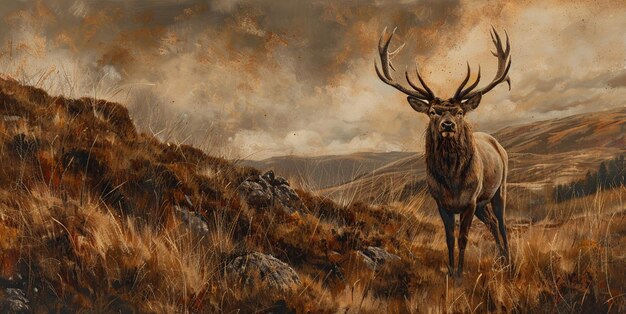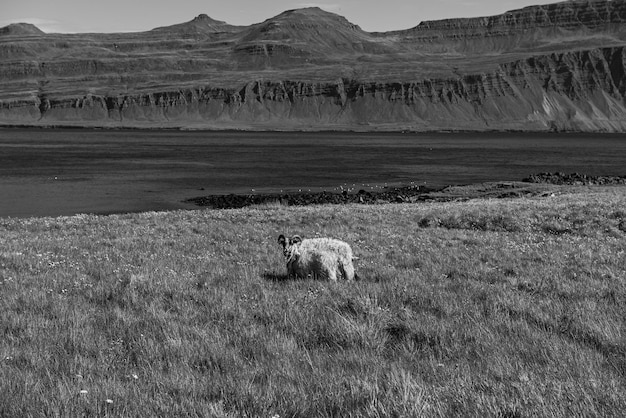Unveiling the Mystery of “The Monarch of the Glen”: A Rediscovered Masterpiece

“The Monarch of the Glen,” painted by Sir Edwin Landseer in 1851, is an iconic depiction of a red deer stag that embodies the romantic ideal of the Scottish Highlands, showcasing Landseer’s exceptional ability to capture animal anatomy and imbue his subjects with human-like emotions.
Step into the majestic world of Sir Edwin Landseer’s “The Monarch of the Glen,” a painting that has become synonymous with the rugged beauty of the Scottish Highlands. While the image might seem familiar, the story behind this iconic artwork is rich with historical context and artistic significance, often overlooked in its widespread reproduction.
Discovering “The Monarch of the Glen”: An Enduring Symbol
Sir Edwin Landseer’s “The Monarch of the Glen” is more than just a painting; it is a symbol of Scotland itself. The artwork, completed in 1851, captures the essence of the Highlands, portraying a powerful red deer stag in its natural habitat. This introduction delves into the historical backdrop and artistic choices that have made this painting a lasting icon.
Landseer’s Artistic Vision
Edwin Landseer was a celebrated animal painter of his time, known for his ability to imbue animals with human-like attributes. In “The Monarch of the Glen,” this is evident in the stag’s regal posture and the knowing look in its eyes.
Historical Context of the Painting
The painting was commissioned for the Palace of Westminster, reflecting a growing interest in Scottish themes during the Victorian era. However, it was later sold to private collectors, adding layers to its storied past.
- The painting’s initial purpose was to adorn the Houses of Parliament, symbolizing British power and unity.
- Its subsequent sale and journey through various collections added to its mystique and accessibility.
- The image’s widespread use in advertising and popular culture solidified its iconic status.
Beyond its visual appeal, “The Monarch of the Glen” is a window into the Victorian fascination with the Highlands and the romantic ideals associated with the region. Landseer’s skill in capturing the animal’s anatomy and emotional depth has ensured its place in art history. The painting continues to resonate with audiences, evoking a sense of awe and connection to the natural world. It serves to remind us of both the power and vulnerability of nature, prompting reflection on the balance between human ambition and environmental preservation.
The Creation of a Masterpiece: Landseer’s Techniques and Influences
To truly appreciate “The Monarch of the Glen,” it is essential to understand the techniques and influences that shaped Landseer’s artistic approach. This section explores the details of his craft, his contemporaries, and the unique blend of realism and romanticism that defines his work.
Landseer’s mastery of animal anatomy is evident in the precise rendering of the stag’s musculature and posture. His ability to capture the animal’s essence, combined with his romantic sensibilities, set him apart from his peers.

His legacy lives on through his influence on subsequent generations of animal painters, particularly those who sought to capture the beauty and drama of the natural world. Landseer’s innovative techniques and expressive style continue to inspire artists today, demonstrating the lasting impact of his artistic vision.
Influences on Landseer’s Style
Landseer was influenced by the Romantic movement, evident in his dramatic compositions and emotional portrayals of animals. He combined this with a keen eye for detail, resulting in a unique and compelling style.
Techniques Used in “The Monarch of the Glen”
Landseer employed techniques such as glazing and scumbling to achieve the painting’s rich colors and textures. These methods allowed him to create a sense of depth and realism.
- Glazing involves applying thin layers of translucent paint to build up color and luminosity.
- Scumbling uses dry brushing to create a textured effect, adding to the painting’s tactile quality.
- Landseer’s attention to detail in rendering the stag’s fur and antlers showcases his technical skill.
Landseer’s blend of romanticism and realism, combined with his technical expertise, made “The Monarch of the Glen” a groundbreaking work of art. His ability to convey emotion through his animal subjects resonated with audiences, cementing his reputation as a leading artist of his time. The painting’s enduring appeal lies in its ability to evoke a sense of wonder and connection to the natural world, prompting viewers to reflect on the power and beauty of the Scottish Highlands.
The Highland Setting: Landscape and Symbolism
The rugged landscape of the Scottish Highlands plays a crucial role in “The Monarch of the Glen.” This section explores the significance of the setting, its symbolic meaning, and how Landseer uses the environment to enhance the painting’s overall impact.
The Highlands as a Symbol
In the Victorian era, the Highlands represented a romantic ideal of wilderness and freedom. Landseer tapped into this sentiment, creating an image that resonated with the public’s imagination.
Elements of the Highland Landscape
The painting features elements such as heather-covered hills, rocky outcrops, and a dramatic sky, all of which contribute to the sense of grandeur and remoteness.
- The heather symbolizes the wild, untamed nature of the Highlands.
- Rocky terrain emphasizes the ruggedness and resilience of the landscape.
- The dramatic sky adds to the overall sense of drama and grandeur.
The Highland landscape in “The Monarch of the Glen” is not merely a backdrop but an integral part of the painting’s narrative. It reinforces the themes of freedom, resilience, and the untamed beauty of nature. Landseer’s skillful depiction of the Highlands captures the essence of this iconic region, inviting viewers to immerse themselves in its majestic presence. This connection to the landscape enhances the painting’s emotional impact, prompting reflection on both the power and fragility of the natural world.
The Stag as a Cultural Icon: Meaning and Interpretation
“The Monarch of the Glen” is celebrated for its depiction of the red deer stag, which has become a potent cultural symbol. This section explores the various meanings and interpretations associated with the stag, as well as its role in shaping perceptions of the Scottish Highlands.
The stag is often seen as a symbol of strength, nobility, and the wild spirit of the Highlands. Landseer’s portrayal captures these qualities, making the painting a powerful representation of Scottish identity.
Symbolism of the Red Deer Stag
The red deer stag is an emblem of Scotland, representing the country’s wild beauty and national pride. Its inclusion in “The Monarch of the Glen” reinforces these associations.

The painting’s enduring appeal lies in its ability to tap into these deep-seated emotions, prompting viewers to reflect on the enduring power of nature and the rich cultural heritage of Scotland. By understanding the symbolism and cultural significance of the stag, we gain a deeper appreciation for “The Monarch of the Glen” and its lasting impact on art and society.
Interpretations of Landseer’s Stag
Some interpret the stag as a symbol of the declining Highland way of life, while others see it as a celebration of Scottish identity and resilience.
- The painting can be seen as a commentary on the changing landscape of the Highlands during the Victorian era.
- It also celebrates the enduring spirit and cultural identity of the Scottish people.
- The stag’s majestic presence serves as a reminder of the power and beauty of the natural world.
The stag in “The Monarch of the Glen” is more than just an animal; it is a symbol of Scotland’s cultural identity, resilience, and connection to the natural world. Landseer’s portrayal captures the essence of this majestic creature, inviting viewers to reflect on the rich heritage and enduring spirit of the Scottish Highlands.
From Westminster to Popular Culture: The Journey of the Painting
From its initial commission for the Palace of Westminster to its widespread use in popular culture, “The Monarch of the Glen” has had a remarkable journey. This section traces the painting’s trajectory, highlighting its changing ownership, its role in advertising, and its enduring presence in the public consciousness.
Commission and Early History
Initially intended for the Houses of Parliament, the painting was later sold to private collectors, marking the beginning of its journey through various collections.
The Painting in Advertising
Over the years, “The Monarch of the Glen” has been used in numerous advertising campaigns, cementing its iconic status. Its association with products such as whisky and tourism has made it a familiar image worldwide.
- The painting’s use in advertising has contributed to its widespread recognition and cultural significance.
- It has been used to promote products and destinations associated with Scotland.
- The image has become synonymous with the rugged beauty and romantic appeal of the Highlands.
The journey of “The Monarch of the Glen” from Westminster to popular culture is a testament to its enduring appeal and cultural significance. Its transformation from a commissioned artwork to a widely recognized symbol reflects its ability to resonate with audiences across generations. The painting’s presence in advertising and popular culture has solidified its iconic status, ensuring its place in the collective imagination. By tracing this remarkable journey, we gain a deeper understanding of the painting’s impact on art, society, and the cultural landscape of Scotland.
Preservation and Legacy: Ensuring the Future of “The Monarch of the Glen”
As a treasured work of art, “The Monarch of the Glen” requires careful preservation to ensure its survival for future generations. This section explores the efforts to conserve the painting, its legacy in art history, and its continuing relevance in contemporary society.
Conservation efforts are essential to protect the painting from deterioration and damage. Art historians and conservators work diligently to maintain its original beauty and integrity.
Conservation Efforts
The painting has undergone extensive conservation to repair damage and prevent further deterioration. These efforts ensure that it remains in good condition for future generations.
Landseer’s Lasting Impact
Landseer’s influence on animal painting and his contribution to Scottish art history are undeniable. “The Monarch of the Glen” remains his most iconic work, continuing to inspire artists and captivate audiences.
- Landseer’s attention to detail and emotional depth set a new standard for animal painting.
- His portrayal of the Scottish Highlands helped to shape perceptions of the region.
- “The Monarch of the Glen” continues to be celebrated as a masterpiece of Victorian art.
The preservation and legacy of “The Monarch of the Glen” are vital to ensure that this iconic artwork continues to inspire and captivate audiences for generations to come. Conservation efforts, combined with an appreciation for its cultural significance, will help sustain its presence in art history. Landseer’s lasting impact on animal painting and his contribution to Scottish art are undeniable, making “The Monarch of the Glen” a timeless masterpiece that embodies the beauty, power, and enduring spirit of the Scottish Highlands.
| Key Point | Brief Description |
|---|---|
| 🎨 Landseer’s Techniques | Mastery of animal anatomy and use of glazing/scumbling. |
| 🏞️ Highland Setting | Symbolic landscape of ruggedness and remote beauty. |
| 🦌 The Stag’s Symbolism | Represents strength, nobility, and Scottish identity. |
| 🖼️ Journey to Icon Status | From Westminster commission to popular advertising symbol. |
Frequently Asked Questions
▼
Sir Edwin Landseer (1802-1873) was a renowned English painter, particularly famous for his animal paintings. He had a unique ability to portray animals with human-like qualities, earning him widespread acclaim during the Victorian era.
▼
The red deer is a national symbol of Scotland, representing the country’s wilderness and natural beauty. It embodies strength, independence, and the spirit of the Highlands, making it a significant emblem in Scottish culture.
▼
“The Monarch of the Glen” has been widely used in advertising campaigns, most notably for products associated with Scotland, such as whisky and tourism. Its iconic status has made it a recognizable and enduring image in popular culture.
▼
Landseer employed techniques such as glazing and scumbling to achieve the rich colors and textures in “The Monarch of the Glen.” These methods allowed him to create a sense of depth and realism, enhancing the painting’s visual impact.
▼
“The Monarch of the Glen” is part of the collection of the Scottish National Gallery in Edinburgh, Scotland. Visitors can view this iconic artwork in person, experiencing its grandeur and beauty firsthand.
Conclusion
In conclusion, “The Monarch of the Glen” remains a powerful symbol of the Scottish Highlands and a testament to Landseer’s artistic skill. Its journey from a commissioned artwork to a cultural icon highlights its enduring appeal and continuing relevance in contemporary society, solidifying its place as a true masterpiece.





